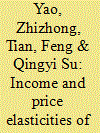|
|
|
Sort Order |
|
|
|
Items / Page
|
|
|
|
|
|
|
| Srl | Item |
| 1 |
ID:
141174


|
|
|
|
|
| Summary/Abstract |
Many middle income economies have been unable to advance to become high income economies over a period of 50 years or longer, not due to the existence of middle income traps, but because of the overly broad income range in the definition of middle income economies. The middle income trap is, in essence, a growth trap, and refers to the situation in which a middle income economy experiences growth stagnation or a growth rate that is lower than that of high income economies. Nonetheless, it is hard to fully comprehend the formation of the trap solely based on growth theories. Historical data indicate that the middle income economies do not lack growth potential, and the real problem is that although their long-term average growth rates are higher than those of the high income economies, their average growth rates over a business cycle or an even longer period of time often fall below those of the high income economies. The cause of this phenomenon is neither short-term macroeconomic fluctuations nor long-term growth potential, but the frequent occurrence of financial crises in middle income economies. As a middle income economy, China is also facing the risk of a financial crisis, and the key to avoiding the middle income trap is to guard against future financial crises, preventing unsound financial liberalization and mismanagement of the corporate debt ratio.
|
|
|
|
|
|
|
|
|
|
|
|
|
|
|
|
| 2 |
ID:
119153


|
|
|
|
|
| Publication |
2013.
|
| Summary/Abstract |
The appearance of new product varieties and improvements in the quality of goods have both played key roles in the rapid growth of China's exports. However, these two important elements have not been formally integrated into the demand equations for China's exports. As we demonstrate in this paper, income elasticity will be underestimated if new varieties of goods and quality improvements are omitted in price index and quantity index calculations, which are necessary for estimating the export demand function. Moreover, the faster new product varieties enter export markets, the greater the underestimation will be. In this paper, we develop an export demand equation that takes into account new product varieties and improvements in quality, and then calculate the demand function for China's exports using the data from 1992 to 2006. According to our estimation, the short-term income elasticity of demand for China's exports is approximately 2.34, and the short-term price elasticity is approximately -0.65. Our estimation predicts an increase in China's export value in the case of an RMB appreciation or export rebate rates reduction in the short term, due to the low price elasticity of China's exports, whose absolute value is less than 1. Our findings are novel and could have significant policy implications.
|
|
|
|
|
|
|
|
|
|
|
|
|
|
|
|
|
|
|
|
|